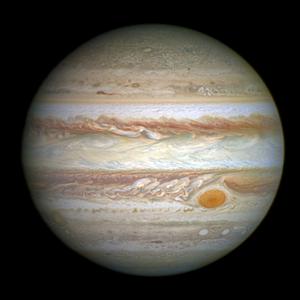Glossary term: Great Red Spot
Description: The Great Red Spot is a gigantic anticyclonic storm in the atmosphere of Jupiter located at 22 degrees south of its equator. About 15,000 kilometers (km) long and nearly 12,000 km wide, it is currently a little larger than Earth, although it has reached much larger dimensions in the past. Winds within the Great Red Spot can reach more than 400 kilometers per hour (km/h) (250 miles per hour (mph)). The reason for its red color is currently unknown although there are several competing hypotheses. A large red spot on Jupiter was discovered by the astronomer Giovanni Cassini in 1665 and was observed for half a century. However there is a century-long gap in observations so it is not known if this spot is the same feature as the one seen for the last two hundred years.
Related Terms:
See this term in other languages
Term and definition status: This term and its definition have been approved by a research astronomer and a teacher
The OAE Multilingual Glossary is a project of the IAU Office of Astronomy for Education (OAE) in collaboration with the IAU Office of Astronomy Outreach (OAO). The terms and definitions were chosen, written and reviewed by a collective effort from the OAE, the OAE Centers and Nodes, the OAE National Astronomy Education Coordinators (NAECs) and other volunteers. You can find a full list of credits here. All glossary terms and their definitions are released under a Creative Commons CC BY-4.0 license and should be credited to "IAU OAE".
If you notice a factual error in this glossary definition then please get in touch.
Related Media
Jupiter
Credit: NASA, ESA, and A. Simon (Goddard Space Flight Center) credit link
License: CC-BY-4.0 Creative Commons Attribution 4.0 International (CC BY 4.0) icons









